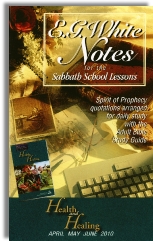|
||||||||||||||
Commentary on "Celebrating Spiritual and Physical Fitness"
Day 5: Wednesday, April 14, 2010
Overview
Today’s lesson swings back to the authors’ emphasis on a physical aspect of the Christian life: exercise. The study makes a connection between physical exercise and spirituality by an appeal to the biblical idea of the body being the temple of the Holy Spirit, emphasizing that Adventism does not believe in Greek dualism that holds the body is evil. Mixed with this Gnostic view and seen as part of this pagan understanding of reality is the immortality of the soul.
In contrast with this view the current lesson makes the point that physical well-being directly and substantially affects believer’s spirituality. While mercifully the expectations for believers’ physical training are not as high and burdensome as are those of a professional athlete, nevertheless simple and basic physical exercises aren’t optional.
Observations
While the rejection of the Gnostic view of physical reality as being intrinsically evil is commendable, the authors fail to understand the Christian doctrine about the human spirit, which they incorrectly place in the category of pagan Gnosticism. The authors explain their position by assuming that other believers are supposedly affected by pagan ideas and are neglecting physical exercise because they think that the soul is disconnected from the body and is unaffected by it, or they see the body as being intrinsically evil and treat it accordingly in a negative way.
The Adventist understanding of spirituality is presented as a comprehensive perspective operating on the principle that what affects the body affects the spirituality of the person because what the Bible calls soul or spirit is considered a part of the physicality of the body. In this view physical exercise—or anything that improves how the body functions—automatically improves the spirit which is part and parcel of the body.
As strange as it may appear to those who operate with these assumptions, Christians do not think that what happens with the body is unrelated with spirituality. Rather, Christians believe man was created body and spirit, with the spirit being not merey life-principle or energy which animates the body, but something distinct and different in substance than the body. This spirit is the true locus of man’s identity; the body is just what clothes the spirit. In biblical language the man lives in the body as he would live in a tent, and these tents are expendable. They can and will be changed while the core, the spirit, remains intact (see for example 2 Cor. 5:2-4, 2 Peter 1:13).
When man sinned, his sin affected all his parts, both his spirit or soul, and his body. It is important to emphasize at this point that the Bible places the locus of control in the spirit and not in the body. The body, while affected by sin, is nevertheless just the vehicle lead by man’s dead spirit. After the fall, man’s first and foremost problem with sin was that his spirit is now dead in sin and trespasses (Ephesians 2:1, 5). That this deadness is attributed properly to the spirit becomes evident when the remedy, spiritual resurrection (verse 5), is seen as a radical change in contrast with the previous state.
Obviously this spiritual life can’t refer to the body, because the body remains unchanged until the resurrection. The believer looks forward for the redemption of the body (Romans 8:23). This sinful, dead body remains affected by sin even in believers: “The body is dead because of sin” (Romans 8:10). Believers still die; the deadness of their bodies is the same as that of unbelievers. The future physical resurrection will resolve the physical problem; for the present only the spirit experiences spiritual life.
It cannot be underestimated how important it is to grasp that the locus and power of sin is in the spirit and not the body, even if the body is affected by it. It’s important because the solution—the breaking of sin’s power—must happen in the spirit, and when it comes to spiritual healing and progress in sanctification, physical exercise or treatment misses the mark completely because it fails to go to the core or heart of the problem. Trying to influence the spirit by affecting the body by trying to ameliorate the negative effects of sin in the body is doomed to failure.
Methods like “Do not handle, Do not taste, Do not touch” which constitute an attempt to show “severity to the body” are “of no value in stopping the indulgence of the flesh” (Colossians 2:21-23). Disciplining the body, while it can be beneficial to health, is inefficient in dealing with sin because sin’s power is located elsewhere. The effects of sin in the body are dealt with by operating on the spirit, not the other way around. The physical body is the car, the soul is the driver. Repairing a flat tire will not make the driver sober if he’s drunk.
At the end of the day, the Adventist assumptions about human spirit having a physical basis prevent realizing the depth and nature of the sickness brought by sin. Further, the Adventist view prevents knowing and applying the proper cure for the spirit dead in sin in addition to misunderstanding the biblical way to progress in sanctification. The Adventist paradigm makes it hard if not impossible for a person to experience true spiritual life and growth. The task becomes easier when it is dealt from the proper angle.
Summary
- The belief that the soul or spirit is of a different substance than and separate from the body is not a pagan idea.
- Physical exercise does not improve spiritual health because the spirit is not part of the body.
- Spiritual life and death occurs in the spirit, not in the mind/physical body.
- Ephesians 2:1-3 describes humanity’s natural spiritual deadness.
- Spirit resurrection does not affect the body but brings the spirit to life (Ephesians 2:4-6).
- The body is still sinful and mortal, affected by death and sin, even when the spirit is alive (Rom. 8:10).
- The locus and power of sin is in the spirit, not the body.
- Trying to influence spirit by physical exercise and health is an impossible task.
- The soul or spirit is the driver of the body, not the other way around.
- With the Adventist paradigm of spirit being part of the body, a physical reality, it is impossible to understand how to remedy the “sin problem”.
- True spiritual life and growth are difficult if not impossible with an Adventist view of body and spirit.
- If we approach the problem of sin as residing in the immaterial spirit, we have much better success.
Copyright 2010 BibleStudiesForAdventists.com. All rights reserved. Revised April 13, 2010. This website is published by Life Assurance Ministries, Glendale, Arizona, USA, the publisher of Proclamation! Magazine. Contact email: BibleStudiesForAdventists@gmail.com.
The Sabbath School Bible Study Guide and the corresponding E.G. White Notes are published by Pacific Press Publishing Association, which is owned and operated by the Seventh-day Adventist church. The current quarter's editions are pictured above.
Official Adventist Resources
Standard Edition Study Guide Week 3
Teacher's Edition Study Guide Week 3
Easy Reading Edition Study Guide Week 3
Search the Complete Published Ellen G. White Writings


